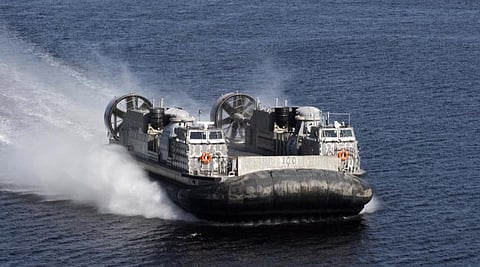

The US Navy has taken delivery of the first three examples of a new class of all-aluminium Landing Craft Air Cushion (LCAC) vehicles designed and built by New Orleans-based Textron Systems Corporation to replace the service's fleet of older LCACs that first saw operational use in the 1980s.
Designated as Ship-to-Shore Connectors (SSC), the LCAC 100-class vessels are built with similar configurations, dimensions, and clearances to the navy's legacy LCACs to ensure their compatibility with existing well deck-equipped amphibious ships as well as the Expeditionary Transfer Docks of the Military Sealift Command.
LCAC 100 and LCAC 101, the first two SSCs, are being used primarily for training of crews. LCAC 102, the third SSC, and all succeeding examples of the series will be used operationally by the navy. Like their predecessors, these hovercraft were designed specifically for the transport of the ground combat elements of the US Marine Corps between the navy's larger, deep-draught amphibious ships and unprepared beaches. Secondary missions will include humanitarian assistance and disaster response (HADR).
The craft are capable of making ship-to-shore transits over a distance of 25 nautical miles, ensuring the larger navy ships can remain in the relative safety of offshore waters when amphibious landings of troops, vehicles, and equipment are conducted in denied areas.
They can also operate independently of tides, water depth, underwater obstacles, ice, or mud – day or night – to provide navy expeditionary strike group commanders with greater operational flexibility as regards the insertion and extraction of ground combat elements. This capability – which Textron said will enable the craft to access more than 80 per cent of the world's shorelines – is also critical in HADR situations wherein relief vehicles and equipment will be transported ashore in ports that had been damaged by disasters, rendering their berths unusable by deep-draught vessels.
Each SSC has an LOA of 92 feet (28 metres), a beam of 48 feet (14.6 metres), a height of 26 feet (7.92 metres), and a four-strong crew consisting of a pilot, a co-pilot, a loadmaster, and a deck engineer. The craft's massive open deck has a total area of 1,608 square feet (149 square metres) and can accommodate a maximum of 74 tons (67 tonnes) of assorted loads main battle tanks and other armoured vehicles, support vehicles, and heavy equipment. Separate from the cargo deck is an enclosed personnel transport module that can house 145 combat-equipped troops or 108 casualty victims.
Power is provided by a quartet of Rolls-Royce MT7 6,168hp (4.6MW) gas turbines to enable each craft to reach speeds of up to 35 knots even under sea state three. Control of the engines is via fly-by-wire joystick, enabling only two bridge crew to operate the vessel. The aluminium and composite construction meanwhile ensures better resistance against corrosion, which in turn will ensure lower life cycle maintenance costs and an operational service life of 30 years.
| LCAC 102 | |
| SPECIFICATIONS | |
| Type of vessel: | Landing craft |
| Flag: | USA |
| Owner: | US Navy |
| Operator: | US Navy |
| Designer: | Textron Systems Corporation, USA |
| Builder: | Textron Systems Corporation, USA |
| Hull construction material: | Aluminium |
| Superstructure construction material: | Aluminium; composite |
| Deck construction material: | Aluminium |
| Length overall: | 92 feet (28 metres) |
| Beam: | 48 feet (14.6 metres) |
| Capacity: | 74 tons (67 tonnes) |
| Main engines: | 4 x Rolls-Royce MT7, each 6,168 hp (4.6 MW) |
| Maximum speed: | 35 knots |
| Other equipment installed: | Cargo deck |
| Accommodation: | Personnel transport module |
| Crew: | 4 |
| Passengers: | 145 |
